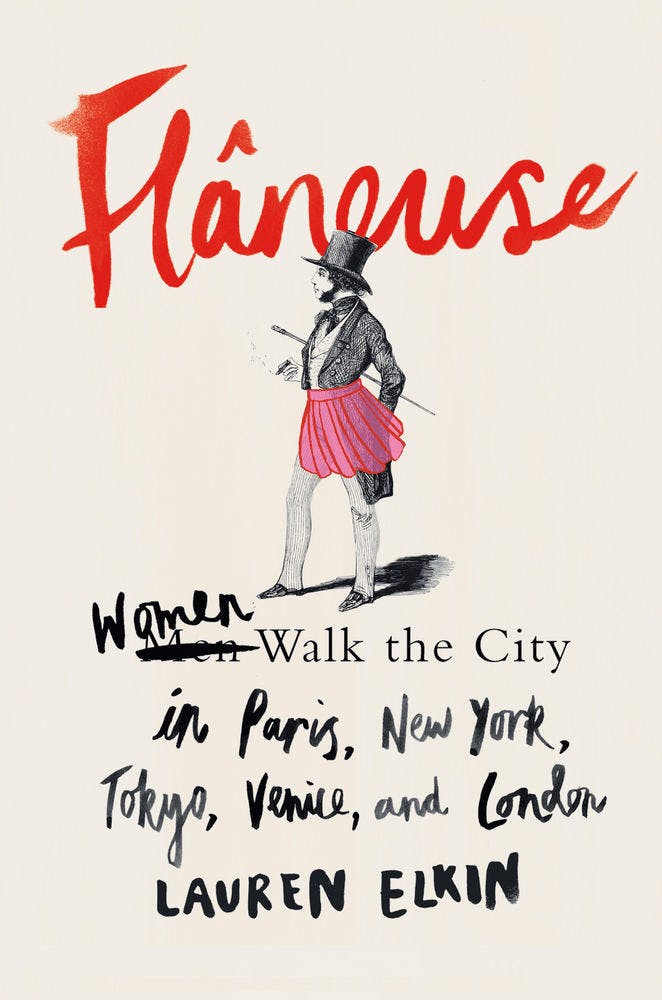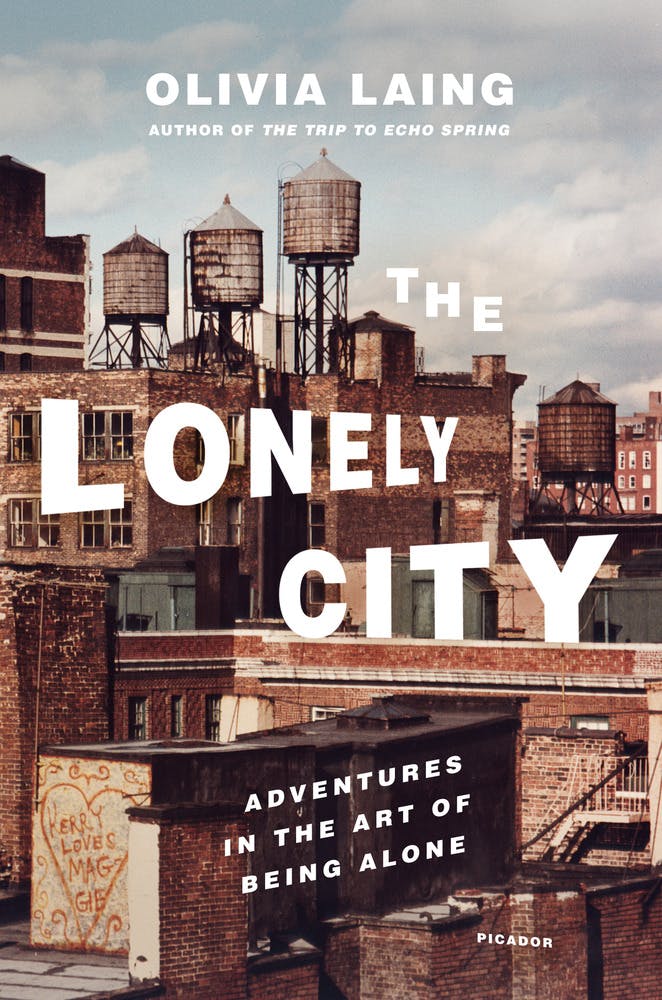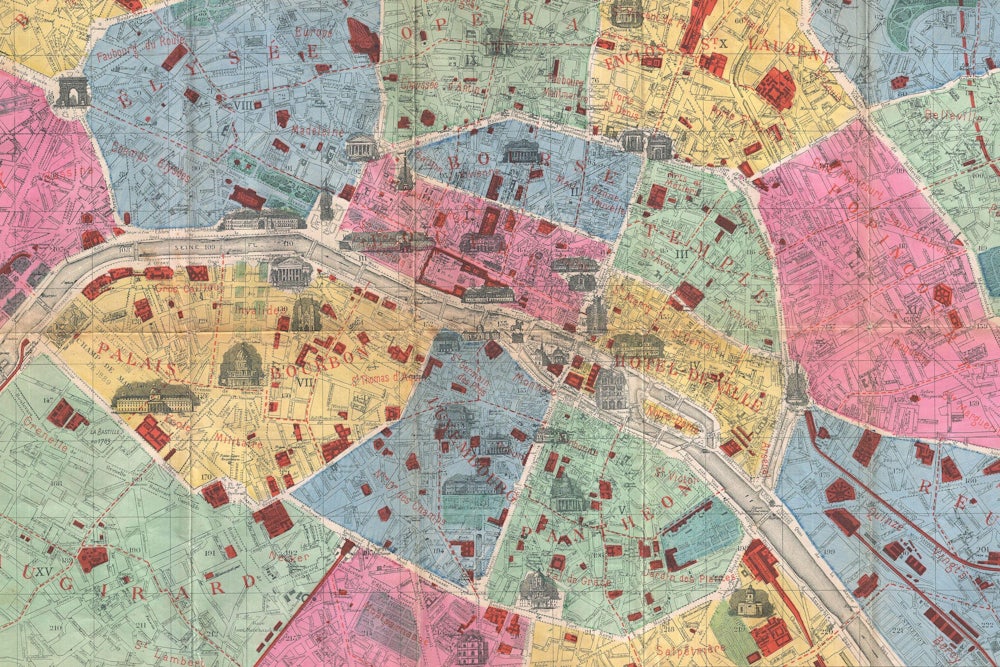The flâneur emerged from the imagination of Charles Baudelaire. In his 1863 essay, “The Painter of Modern Life,” Baudelaire eagerly proposes an ambulatory figure he calls a “passionate spectator.” He is modeled after a real person, Monsieur C.G., but Baudelaire does not disclose any real information about his mind or manners. And anyway, Baudelaire admits, he made him up: “To give complete reassurance to my conscience it must be supposed that all that I have to say of his strangely and mysteriously brilliant nature is more or less justly suggested by the works in question—pure poetic hypothesis, conjecture, a labor of the imagination.” In other words, this wanderer of the city, chronicler of the present, and contradiction-laden figure of the crowd, has always been a myth.
The flâneur crops up every now and again, and he serves different purposes at different times. Walter Benjamin, in the first half of the 20th century, transformed him from a street wanderer to an observer of the damaging effects of modernity and capitalism. In his intended magnum opus, The Arcades Project, the streets he once wandered have transformed into an interior as a result of the construction of arcades: Iron and glass structures that organized Parisian shops, built by Baron Haussmann after he famously demolished swaths of old Paris. The flâneur becomes an observer of the marketplace, his aimless walking a “demonstration against the division of labor.” The flâneur is not apolitical, but he is not himself an actor. He watches, and he walks.
What purpose could the flâneur serve now? We have a variety of answers to that question, thanks to a flood of renewed interest in this figure. The flâneur is the subject of a new book—Lauren Elkin’s Flaneuse: Women Walk the City in Paris, New York, Tokyo, Venice, and London—and is invoked in Olivia Laing’s The Lonely City: Adventures in the Art of Being Alone. The flâneur is also central to a new exhibition at the Jewish Museum in New York, called The Arcades: Contemporary Art and Walter Benjamin. Elkin and the curators of the Jewish Museum use the flâneur as a lens for interpreting the world (Laing does something a little different). But while the flâneur is an interesting idea, he doesn’t hold water as a paradigm for understanding our historical moment.
Lauren Elkin’s central question is: Can a woman be a flâneur? She is not the first to ask this question. Her book draws from a history of scholarship around the female flâneur, popularly driven by the work of Janet Wolff. But where Wolff and others succeed in making a case for this figure, Elkin does not.
Elkin’s introduction to flânerie begins with a study abroad trip to Paris in the 1990s. The young American takes to the city and eventually it becomes her home. In her reading, the flâneur is a masculine figure, privileged, and an icon of leisure. The city, which he mapped with his walks, was a playground, the spectacle for his spectatorship. Elkin soon begins to think critically about whether or not a woman could be a spectator. Her answer is, simply, yes. “To suggest that there couldn’t be a female version of the flâneur is to limit the ways women have interacted with the city to the ways men have interacted with the city,” she writes.

Each chapter of Elkin’s book centers around a city, pairing her personal experiences with an analysis of a female cultural or historical figure—Jean Rhys in Paris, Virginia Woolf in London—who also performed flânerie. There are times when the conceit is stretched to the tearing point. In “Neighborhoods,” she tries to connect herself to Cléo of Agnes Varda’s French New Wave classic Cléo de 5 à 7. The film follows Cléo for two hours as she waits to find out the results of her biopsy. Elkin makes bold claims (“This is Varda’s version of cinematic flânerie”), as well as ones that betray a shaky understanding of her book’s central concept (“The driver is a flâneuse on wheels”).
After nearly a decade in Paris, her dreams of truly making France her country are interrupted by the bureaucracies of government and the reality of borders. While she waits to hear about the status of her French citizenship, Elkin returns to New York, dejected and uncertain, and finds herself wandering. The “Return” chapter explicitly remarks on citizenship, the politics of space, and the idea of home. A French security guard says to her, “Well, you know...it’s hard for us to come to your country too.” She responds angrily:
This was another reason I hated this security guard. OK, you can’t go to America, I wanted to say to him, but you can go to Spain, Greece, Italy, the U.K., take your pick. The project of the European Union was to pronounce the free circulation of people and goods, a lesson learned from a century of world wars: that borders may serve some administrative purpose but in the pursuit of capitalism and the common good they must be easier to cross.
Later, Elkin touches on the refugee crisis, and the hard nationalism now cursing Europe. But these political thoughts never cohere, never match the intensity with which she thinks about her love for walking around. When they come close, Elkin seems to, in fact, be writing about contemporary cosmopolitanism, not the nineteenth-century flâneur. “I have learned that it is an act of empathy to be able to un-root yourself, to recognize that none of us are protected by place,” she writes. “My city isn’t mine anymore. And yet it always will be, more than any other.” These are not the words of Baudelaire’s wanderer, who cared only for meditations on beauty and the present moment.
The flâneur is not the right architectural frame on which to build a politics of what it means to walk around cities these days. In fact, he seems to get in the way of what Elkin is really trying to write about, as if by constantly walking backward and forward he is obstructing her view.
The Jewish Museum’s new exhibition is based on Walter Benjamin’s enormous and uncompleted Arcades Project, also known as Passagenwerk, which he worked on from 1927 until his death in 1940. The show’s curator Jens Hoffmann has chosen artworks to match up with the lettered fragments of the Arcade Project’s “Convolutes” section—e.g., “T: Modes of Lighting,” “M: The Flâneur,” “K: The Commune.” As you enter, metal bars crowd over your head in a half-semblance of an actual structure.
The sequenced stations feature fine works by artists like Cindy Sherman, Timm Ulrichs, and Rodney Graham. The Sherman piece is matched up with “H: The Collector”: It shows the artist dressed up as a rich older lady in a high-necked sequin dress. There are some bits of Benjamin text up on the walls. Alongside the artwork and quotations are chopped-up texts by none other than the controversial poet Kenneth Goldsmith, adding yet more content to an already very full space. (In 2015, Goldsmith was widely condemned for a crass performance in which he read Michael Brown’s autopsy report aloud.)
The result is a maddeningly overcrowded exhibition in which at least three trains of thought (Benjamin’s, the artworks’, Goldsmith’s) jostle for attention. The show is so programmatic (literally, in alphabetical order) that the viewer feels as if her head is in a vise while she is pushed around through some kind of laborious immersive performance on wheels. It is perhaps the opposite experience of exploring Paris, looking at beautiful things that don’t announce themselves.
Hoffmann’s exhibition essay “The Return of the Flâneur” seizes on the old ambulatory chestnut as a mode for absorbing art. The flâneur looks, and viewers of art look, and so this makes sense, Hoffmann implies. The show “enables visitors to inhabit the role of the flâneur, Benjamin’s archetypal leisured city dweller,” he writes. “Perhaps visitors will be inspired to carry this attitude with them as they leave the museum, reassessing their position in society and hopefully realizing that the world is not a fait accompli but a transformable situation.”
But what viewer is an archetype? And how does this archetypal leisured city dweller go about “reassessing their position in society”?
The flâneur walks around the city. He is in constant pursuit of knowledge, appreciates aesthetics, and feels most at home in crowds. He is a default subject with no markers of identity. He is male and unattached, or simply a converted feminine mirror, in Elkin’s conception. He is pure receptacle, a pair of eyes with no human relationships and a politics only of witnessing.
In our moment, writers and curators may be drawn to the flâneur because he represents the opposite of identity politics, and a fantasy of a time when a universal subject was a realistic proposition. Our contemporary discourse holds that who you are influences the way that you know, and the way that you can or cannot speak. A woman walking through the world knows in a different way than a man, and by default has greater authority when describing her viewpoint.
Critics of identity politics would rather that knowledge were an uncolored thing. The flâneur offers a traditional and old-fashioned way to move through the world, and thinkers exploit his model when they lust for the lost universals of political thought. Anybody can be a flâneur, writers like Lauren Elkin say. Look at me do it. But the reason anybody can do it is that the flâneur is nobody.
Though beset by its own theoretical problems (its upper middle class aesthetic, its exclusion of forced migrants), cosmopolitanism is the better model for the mobile subject. Like the flâneur, the cosmopolitan is defined by mobility. But in the cosmopolitan’s case, to be mobile means to absorb other cultural forms. The scholars Zlatko Skrbiš and Ian Woodward write that the “cosmopolitan identity is one that has been marked by encounters with difference.” The cosmopolitan thus exceeds Baudelaire’s narrow idea of flânerie. Cosmopolitans are not just receptive to other cultures, but seek to develop and exercise a sense of intercultural mastery.

In her book The Lonely City, Olivia Laing conceives of a kind of emotional cosmopolitanism. She is alone in New York City, where she has travelled for love, only to be dismissed by her lover. Overwhelmed by loneliness, Laing takes many walks. “So much of the pain of loneliness is to do with concealment,” she writes, “with feeling compelled to hide vulnerability, to tuck ugliness away, to cover up scars as if they were literally repulsive.” For Laing, there is nothing universal about being by oneself. It is as tailored to the individual as shame or desire.
Laing cannot avoid citing Baudelaire on the flâneur. But she immediately jumps off from his essay into something more pertinent, namely our attraction to virtual modes of exploration and community, which she links to a post-AIDS desire to reject the physical body. Laing has no need of the flâneur model, no wish to repurpose it into a tool to do her work for her.
Instead, a radical and politicized empathy animates her conclusion. “Loneliness is personal, and it is also political,” she writes. We feel it as individuals, but it is driven by the politics of acceptability and the stigma of being outside relationships. “Loneliness is collective; it is a city,” she writes. The flâneur is not part of Laing’s vision of what it means to be an individual moving through urban space. Even when we are lonely “we are in this together,” in “this accumulation of scars, this world of objects, this physical and temporary heaven that so often takes on the countenance of hell.”
Kindness, solidarity, alertness, openness: This is the politics we must practice. As Laing writes, “if we know anything from what has gone before us, it is that the time for feeling will not last.” We waste our time when we walk right past.
